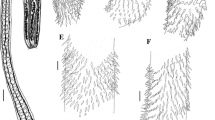Abstract
Three new genera of trypanorhynch cestodes are described from Australian elasmobranchs: Cetorhinicola acanthocapax n. g., n. sp. from Cetorhinus maximus (Gunner, 1765), with four bothridia joined by avelum, a typical heteroacanthous armature with the ends of the hook rows not meeting on the external surface, and enlarged hooks on the base of the tentacle; Shirleyrhynchus butlerae n. g., n. sp., from Dasyatis fluviorum Ogilby, 1908 and D. sephen (Forsskal, 1775), with four bothridia, typical heteroacanthous armature, enlarged basal hooks, testes in linear rows, and lacking seminal vesicles; Stragulorhynchus orectologi n. g., n. sp., from Orectolobus tentaculatus (Peters, 1864) (type-host), O. maculatus (Bonnaterre, 1788) and O. ornatus (de Vis, 1882), with four bothridia, poeciloacanthous armature, with a band of hooklets on the external surface of the tentacle, external seminal vesicle, hermaphroditic duct, accessory seminal vesicle and post-ovarian testes. None of the new genera is readily accommodated by the existing classification of the Trypanorhyncha: the first two genera are tentatively allocated to the Gilquiniidae and the last to the Gymnorhynchidae.
Similar content being viewed by others
References
Bilqees, F.M. & Khatoon, A. (1980) A new trypanorhynchid family Pseudogilquiniidae including a new genus and species Pseudogilquinia karachiense. Philippine Journal of Science, 109, 89–92.
Beumer, J.P., Ashburner, L.D., Burbury, M.E., Jette, E. & Latham, D.J. (1982) A checklist of the parasites of fishes from Australia and its adjacent Antarctic Territories. Technical Communication No. 48 of the Commonwealth Institute of Parasitology. Farnham Royal: Commonwealth Agricultural Bureaux, 99 pp.
Carvajal, J., Campbell, R.A. & Cornford, E.M. (1976) Some trypanorhynch cestodes from Hawaiian fishes, with descriptions of four new species. Journal of Parasitology, 62, 70–77.
Dollfus, R.-P. (1942) Etudes critiques sur les tétrarhynques du Muséum de Paris. Archives du Muséum National d'Histoire Naturelle. Paris, 6ème sér., 19, 1–466.
Dollfus, R.-P. (1969) De quelques cestodes tétrarhynques (hétéracanthes et pécilacanthes) recoltés chez des poissons de la Méditerranée. Vie et Milieu, 20, 491–542.
Schmidt, G.D. (1970) How to know the tapeworms. Dubuque, Iowa: W.C. Brown Co. Publishers, 266 pp.
Schmidt, G.D. (1986) Hand book of tapeworm identification. Boca Raton, Florida: C.R.C. Press, 675 pp.
Yamaguti (1959) Systema helminthum. II. The cestodes of vertebrates. New York: Interscience Publishers, 860 pp.
Author information
Authors and Affiliations
Rights and permissions
About this article
Cite this article
Beveridge, I., Campbell, R.A. Cetorhinicola n. g., Shirleyrhynchus n. g. and Stragulorhynchus n. g., three new genera of trypanorhynch cestodes from elasmobranchs in Australian waters. Syst Parasitol 12, 47–60 (1988). https://doi.org/10.1007/BF00182028
Accepted:
Issue Date:
DOI: https://doi.org/10.1007/BF00182028




